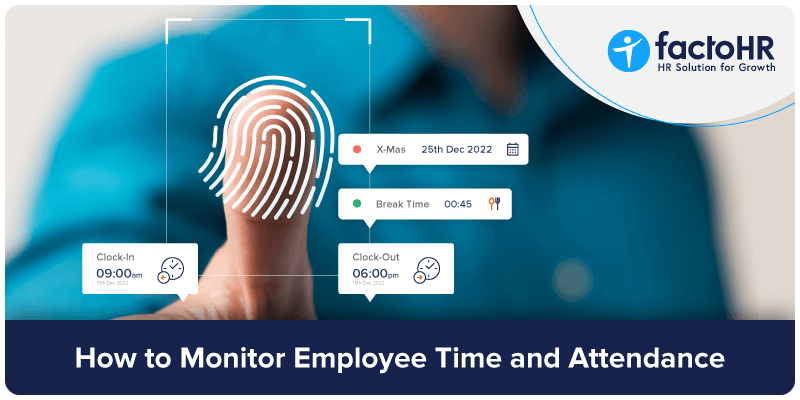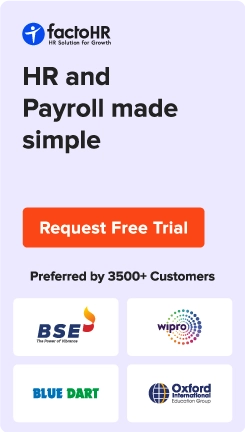How to Monitor Employee Time and Attendance

Table of Contents
Late logins, manual errors, and payroll mismatches lead to company issues. Managing employee attendance is important to ensure employees are being paid correctly. You can monitor time and attendance, which gives a centralized view of employees. You can track arrival times, absences, breaks, overtime, vacation, and personal time here.
Employee attendance management systems, cloud-based or real-time biometric, can simplify attendance tracking and improve employee satisfaction and company productivity. Organizations can make informed decisions regarding the workforce by monitoring productivity and workload across teams. Accurate attendance tracking is essential for precise payroll processing, benefiting both employees and the organization.

What is Employee Attendance Management?
Employee attendance management systems streamline team management, maintain employee work hours, avoid tedious paperwork, and promote work performance. The accuracy of these records reduces costs in the long term and significantly modifies the workload of the HR department.
Why Monitoring Employee Time and Attendance is Important
Monitoring employee attendance is crucial for maintaining organizational efficiency and driving a more organized work culture. Effective attendance tracking enables employees to concentrate on tasks, allows managers to optimize workforce productivity, and helps HR streamline administrative processes. Companies generally monitor their workforce attendance for smooth payroll, resource availability, and allocation. Attendance tracking prevents absenteeism and delays in project timelines.
The labor laws define specific working hours; employers must track and manage attendance to ensure compliance. Companies face legal consequences if they do not follow these regulations, making attendance monitoring a compulsory part of their compliance strategy. Therefore, an accurate attendance management system is essential for ensuring the smooth and efficient operation of the business.

How to Track Employee Time and Attendance with Different Methods
Employee attendance management is a key part of every HR department. You can track employee time and attendance with different methods, such as real-time biometric attendance software, cloud-based attendance management system, mobile app attendance, and geo-fencing. Employee timesheet software records and tracks employees’ work hours, tasks, and attendance. It ensures accurate payroll processing, productivity monitoring, and compliance with labor regulations.
1. Employee Time and Attendance System
HR can manage employees’ time and attendance using all-in-one human resource management software or a separate add-on employee time and attendance system. Using that system, HR can track employees’ sick leave, paid and unpaid leaves, holidays, attendance punctuality, and more. The HR software should be user-friendly and flexible as per the organization.
2. Mobile Tracking System for Remote Employees
A mobile tracking system in HR is a technology used to monitor employees’ real-time location and work hours, particularly for remote, field, or on-site workers. It helps ensure accountability and optimize workforce management. It also simplifies the payroll process and syncs data with the HR portal.
3. Biometric Devices
A biometric attendance system offers secure attendance for employees. It includes fingerprint scans, face recognition, and iris recognition. The biometric device gives huge benefits like employee efficiency, tracking remote employees, cost-effectiveness, and improved employee accountability.
Best suited for
Any suitable attendance tracking method can be used to ensure accurate employee attendance monitoring. If the organization has multiple shifts and a large number of employees, the mobile tracking system is best. If the organization needs secure and effective access control, it can use biometric devices. If the organization wants to manage the whole HR process, not only attendance and payroll, it can use all-in-one HRMS software for flexibility.

Benefits of Tracking Time and Attendance
1. Improving Adherence with Statutes
Compliance with laws and regulations is essential for every business. Maintaining accurate time and attendance records helps prevent potential legal liabilities. Implementing time and attendance tracking software is one of the most effective methods to ensure compliance with labor laws.
Every business has regulatory requirements related to attendance management. A well-regulated attendance system simplifies the responsibilities of HR managers in managing employee attendance efficiently.
2. Get Real-Time Data
Businesses should ensure that they accurately understand their employees’ presence patterns. Real-time data in an attendance management system is one of the most valuable features. This is beyond recording clock-in and clock-out time; it provides insight into increasing productivity, compliance, and operational efficiency.
By using an attendance tracking system, company leaders have real-time data on leave, attendance, and working hours, which improves operational efficiency.
3. Learn about Staff Management
A key role of an attendance management system is to facilitate scheduling and shift management. This system lets managers set up and manage employee schedules based on work times, shift choices, and the company’s needs. Managers can ensure they have the right staff by seeing who’s available.
Manual attendance tracking is time-consuming and error-prone. Attendance management software provides accurate and comprehensive data on each employee, including all relevant details. HR can utilize this system because AMS offers real-time insights into employee attendance patterns.
4. Help Employees Plan Better
A comprehensive Attendance Management System (AMS) helps employees efficiently organize their work schedules, holidays, and meetings. Attendance management facilitates better planning, enhances productivity, and contributes to overall job satisfaction.
Accurate attendance creates a culture of responsibility. Properly recorded leave and attendance data enable employees to plan their core tasks more effectively.
5. Improve Productivity
In today’s competitive business climate, productivity is crucial for an organization’s success. An AMS can enable employees and organizations to do their best by streamlining time recording, attendance accuracy, and accountability. Improving employee attendance is directly linked to improving productivity.

Choose the Best Way to Track Employee Time and Attendance for Your Business
In today’s world, attendance management and tracking are necessary for every organization. factoHR’s attendance management software lets your team clock in and out for every shift and breaks easily. It’s not only about tracking workforce attendance; it’s about understanding your team and promoting a healthy work-life balance.
How to Monitor Staff Attendance?
To effectively monitor attendance, a proper attendance policy should be combined with legal labor laws.
How do You Evaluate Employee Attendance?
Evaluating employee attendance involves examining work hours and leave, determining the proper reason for absence, and implementing clear policies.
What is the best way to record employee attendance?
The best way to record employee attendance is to have a secure, effective, and accurate attendance system. That includes software-based attendance with proper flexible schedules to accommodate employee needs.
Grow your business with factoHR today
Focus on the significant decision-making tasks, transfer all your common repetitive HR tasks to factoHR and see the things falling into their place.

© 2025 Copyright factoHR


